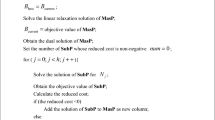Abstract
On the platform of general chemical process simulation software (it was named Optimization Engineer, OPEN), a general optimization algorithm for chemical process simulation is developed using C + + code. The algorithm is based on sequential quadratic programming (SQP). We adopt the activity set algorithm and the rotation axis algorithm to generate the activity set to solve the quadratic programming sub-problem. The active set method can simplify the number of constraints and speed up the calculation. At the same time, we used limited memory BFGS algorithm (L-BFGS) to simplify the solution of second derivative matrix. The special matrix storage mode of L-BFGS algorithm can save the storage space and speed up the computing efficiency. We use exact penalty function and traditional step-size rule in the algorithm. These two methods can ensure the convergence of the algorithm, a more correct search direction and suitable search step. The example shows that the advanced optimization function can meet the requirements of General Chemical Process Calculation. The number of iterations can reduce by about 6.0%. The computation time can reduce by about 6.5%. We combined this algorithm with chemical simulation technology to develop the optimization function of chemical engineering simulation. This optimization function can play an important role in the process optimization calculation aiming at energy saving and green production.
Graphic abstract




Similar content being viewed by others
Availability of data and material
The datasets used or analyzed during the current study are available from the corresponding author on reasonable request.
Code availability
The code required to reproduce these findings cannot be shared at this time because it is part of an ongoing study.
References
Alkaya D, Vasantharajan S, Biegler LT (2001) Successive Quadratic Programming: Applications in the Process Industry. In: Floudas C.A., Pardalos P.M. (eds) Encyclopedia of Optimization. Springer, Boston, MA. https://doi.org/10.1007/0-306-48332-7_515
Biegler LT, Cuthrell JE (1985) Improved infeasible path optimization for sequential modular simulators—II: the optimization algorithm. Comput Chem Eng 9(3):257–267. https://doi.org/10.1016/0098-1354(85)80004-1
Biegler LT, Hughes RR (1985) Feasible path optimization with sequential modular simulators. Comput Chem Eng 9(4):379–394. https://doi.org/10.1016/0098-1354(85)85016-X
Fletcher R (1987) Practical methods of optimization. Wiley, New York
Fletcher R, Leyffer S (2002) Nonlinear programming without a penalty function. Math Programm Ser A 91(2):239–269. https://doi.org/10.1007/s101070100244
Liu MX, Jian JB (2020) (2020) An ADMM-based SQP method for separably smooth nonconvex optimization. J Inequal Appl 1:1–17. https://doi.org/10.1186/s13660-020-02347-3
Jian JB, Ran Q, Zhang XL (2005) A non-strictly complementary SQP algorithm for Minimax problem. Proceedings of China Enterprise Operations Research Academic Exchange Conference (2005). http://cpfd.cnki.com.cn/Article/CPFDTOTAL-NSES200511001040.htm
Karmarkar N (2001) A new polynomial-time algorithm for linear programming. Combinatorica 4:373–395. https://doi.org/10.1007/BF02579150
Kojima M, Megiddo N, Mizuno S (1993) A primal—dual infeasible-interior-point algorithm for linear programming. Math Programm 61(1–3):263–280. https://doi.org/10.1007/BF01582151
Mizuno S (1992) Polynomiality of the Kojima-Megiddo-Mizuno infeasible interior point algorithm for linear programming.Cornell University Operations Research and Industrial Engineering. https://ecommons.cornell.edu/bitstream/handle/1813/8891/TR001006.pdf?sequence=1
Ni Q (2001) Global convergence and implementation of ngtn method for solving large-scale smarse nonlinear programming problems. J Comput Math 19(004):337–346. https://doi.org/10.1016/S0377-0427(00)00605-1
Ni Q, Yuan YX (1997) A subspace limited memory quasi-Newton algorithm for large-scale nonlinear bound constrained optimization. Math Comput 66(220):1509–1520. https://doi.org/10.1090/S0025-5718-97-00866-1
Panier ER, Tits AL, Herskovits JN (1988) A QP-free, globally convergent, locally superlinearly convergent algorithm for inequality constrained optimization. SIAM J Control Optim 26(4):788–811. https://doi.org/10.1137/0326046
Shen CG, Fan CX, Wang YL, Xue WJ (2020) Limited memory BFGS algorithm for the matrix approximation problem in Frobenius norm. Comput Appl Math 39(2):43. https://doi.org/10.1007/s40314-020-1089-9
Wang FS ,Gao J, Zhao YL, Jiang HF (2019) Modal relaxation SQP algorithm based on sequence linear equation sets for the mixed constrained Minimax problem. J Appl Math 2019(2):242–253. http://123.57.41.99/jweb_yysxxb/CN/Y2019/V42/I2/242
Yuan YX (1991) A dual algorithm for minimizing a quadratic function with two quadratic constraints. J Comput Math 9(4):348–359. https://www.researchgate.net/publication/248707141_A_dual_algorithm_for_minimizing_a_quadratic_function_with_two_quadratic_constraints
Yue JC, Zheng SQ, Cheng HN, Han FY (2009) Filter-SQP in modular simulator environment for process optimization. Comput Appl Chem 26(06):729–731. https://doi.org/10.3321/j.issn:0438-1157.2006.03.025
Acknowledgements
This work is supported by the National Natural Science Foundation of China (21406124) and Major science and technology innovation project of Shandong province (2018CXGC1102).
Funding
This work is supported by the National Natural Science Foundation of China (21406124) and Major science and technology innovation project of Shandong province (2018CXGC1102).
Author information
Authors and Affiliations
Contributions
Jianyang Ling and Shuguang Xiang contributed to the conception of the study; Jianyang Ling, Rongshan Bi and Li Xia contributed to the improvement and implementation of the algorithm; Jianyang Ling, Zhen Xu and Li Xia performed the example test; Jianyang Ling, Wenying Zhao and Rongshan Bi performed the data analyses and wrote the manuscript; Jianyang Ling, Rongshan Bi and Li Xia helped perform the analysis with constructive discussions.
Corresponding author
Ethics declarations
Conflict of interest
We declare that we do not have any commercial or associative interest that represents a conflict of interest in connection with the work submitted.
Additional information
Publisher's Note
Springer Nature remains neutral with regard to jurisdictional claims in published maps and institutional affiliations.
Rights and permissions
About this article
Cite this article
Xia, L., Ling, J., Xu, Z. et al. Application of sequential quadratic programming based on active set method in cleaner production. Clean Techn Environ Policy 24, 413–422 (2022). https://doi.org/10.1007/s10098-021-02207-8
Received:
Accepted:
Published:
Issue Date:
DOI: https://doi.org/10.1007/s10098-021-02207-8




